
Rendering lard – is it really as hard as “they” say? Back in the “good old days,” lard was the only fat that was used besides butter for cooking, baking, or even spreading on bread for a sandwich.
Background and History of Cooking Oils
Lard has been used for centuries, ever since people began realizing what could be processed from a pig. Perhaps you have heard the statement, “the only thing not used from a pig is his squeal!”
Now, as we all know (or have heard), lard is the best for cooking, frying, and baking. Almost any old recipe will call for lard. Any new recipe will call for shortening (Crisco or any other brand).
Crisco, a popular brand first sold in 1911 by Procter & Gamble, was the first shortening to be made entirely of vegetable oil. When William Procter and James Gamble started their company, they hired chemist E. C. Kayser to develop a way to hydrogenate cottonseed oil, which ensures the shortening remains solid at normal storage temperatures. The initial purpose was to create a cheaper substance to make candles than the expensive animal fats in use at the time. Electricity began to diminish the candle market, and since the product looked like lard, they began selling it as a food. This product became known as Crisco, its name derived from the initial sounds of the expression “crystallized cottonseed oil.”
I recently stopped using shortening in my cooking, by adding extra butter (never margarine) in cookies and cakes instead of the shortening called for in the recipes. However, according to some sources, lard is actually better than butter in many ways. It is supposed to contain less fat. So now that I have a big supply of lard, I am using that in the cookies and they are turning out very well.
Ways to Get Lard
In these modern times, you can purchase a pound of lard just like a pound of butter in grocery stores – well maybe not ALL stores, but in the ones I frequent. However, if you purchase lard, it sometimes has preservatives in it … and aren’t we all trying to get rid of those?
We have purchased a pig these past two years from a local farmer who does not have the big commercial pig farms like some in this area. The meat is good and the price is “right.” Our farmer takes our pig to the butcher and we tell the butcher how we want it cut up, then we collect it when it is done. Each time I pick up the pig, I have them save the lard for me, planning on rendering it for home use.
You may be able to “pre-order” lard from a butcher if you don’t purchase your own pigs. Most customers do not keep their lard, so the butchers will probably have a lot on hand and keep it if they know someone wants it.
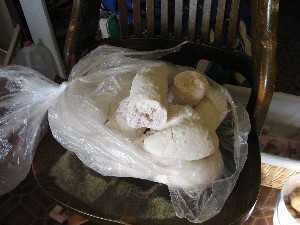
How to Make Your Own Lard
I finally rendered lard this winter … two year’s worth, but it was not any harder to do two years’ supply than one year’s supply.
Rendering my lard was not difficult – it was even fun. I was warned that the process would smoke and stink up my house, so I planned on doing it outside. However, the weather has not been cooperating, so I decided to try it inside anyway. Yes, it does smell, but not terribly – kind of like cooking bacon all day long.
The lard came from the butcher in large tubes, like sausages without the casing, and it was frozen. I put it into my large (18 quart) stainless steel stockpot and started simmering with as low a heat as the stove would go. Because it was frozen, it took a while to melt and start looking like golden water. I started it the night before, but I know my stove and was confident that the flame would not go out or get hotter. By mid-morning the next day, it was melted enough to begin straining it.
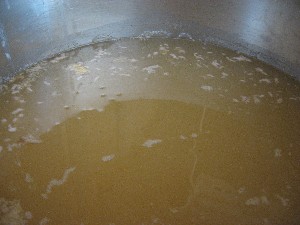
I tried a coffee strainer, but it didn’t work well, so I used part of an old (clean, of course) pillow case draped over a strainer, which worked marvelously. Cheesecloth would also work. The cracklings (meaty pieces left over from the clean lard) are being given to the chickens, a little bit at a time. My husband Norm says it will make laying the eggs easier, as the cracklings and leftover lard will grease the eggs coming out … who ever told him he was funny?
After the lard was strained, I put it into a smaller (12 quart) stainless steel pot and heated it up again. At the same time, I heated quart jars and lids, and then poured the liquid lard into the jars to seal. It didn’t take long for the seal to take and now I have jars of lovely white lard to use – probably half a lifetime’s worth!
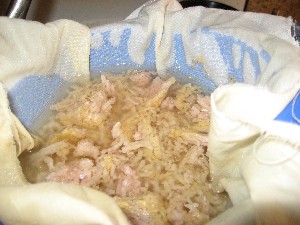
I still had about three-quarters of a can of Crisco sitting in my pantry. I hate to throw things away, as it is a waste, but what should I do with it? If it isn’t good enough to go into MY body (or my family’s), it shouldn’t go into the chickens’ bodies. So I threw it away. Just picked up the can, carried it to the garbage can and threw the WHOLE THING away … no guilty feelings at all!
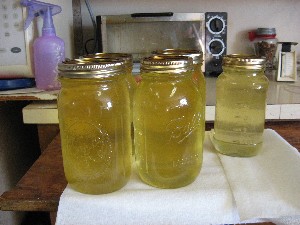
Some Uses for Lard
Now that I have lard, what will I do with it? My ‘lard’ crock has always been filled with shortening – I faked it when I was working at Historic Murphy’s Landing by using the Crisco instead of real lard.
I washed out the crock and now have actual, honest-to-goodness, lard in it. Not much, as I’m not sure how long it will stay good out of the fridge or sealed in a jar, but enough to coat the pans I season and use for frying – instead of vegetable oil or shortening. I will not give up my olive oil for frying, but plan on doing what little deep frying I do with lard instead of vegetable oil. Sources say it’s better and has a higher smoke temperature. I haven’t tried it, yet, as I deep fry so very little.
I have a recipe for homemade Bisquick mix and will now use lard instead of shortening – I threw away what I had made with Crisco and am making small batches (again with the concern of spoilage) with lard and organic unbleached white flour from the local Co-op.
I mix up my cookie dough with half butter and half lard (most have that mixture in the recipe) and they are turning out moist and yummy. I do find that the cookie dough tastes a little bit different. (If you are like me, you taste the dough before baking the cookies.)
Shortening has no flavor, but lard has a bit of ‘nutty’ flavor and you really can tell the difference before baking. After baking, you cannot. Norm doesn’t know the difference between the old ones made with shortening and the new ones made with lard.
So, that’s everything about lard you wanted to know and were afraid to ask. Simply put, you too can render lard – it’s “easy as pie!”
Editor’s Note: This article was first published in 2007.

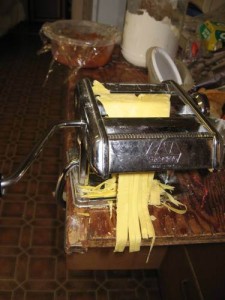































Oh, my, that brought back some memories! I’ve rendered lard in the oven of a wood cookstove and kept it in a cold pantry. Speaking of pies, real (“homemade”) lard will make the best pie crust you ever made.
I love baking and cooking with lard. We render down our own lard. I love the expressions I get when people eat home made stuff made home made lard. The fresh taste, nothing artifical..
Great post! The farm I do some work for has lard that I could get, I’ll have to give it a try as I’ve never used it before. I’m wondering how it would affect the flavor or physicality of say, a pie crust.
When I was growing up on the old farm we used a lot of lard. Of course all pie crusts were made with lard but most other baking was done with half butter/half lard. There was exceptions, all spice cakes, gingerbread and cookies were made with 100% lard. I don’t know why this was done buy boy I do remember how delicious they were. Mom’s favorite was Applesauce Spice Cake with Carmel Frosting. It was chock full of nuts, raisins and of course chunky homemade applesauce. It was fantastic and made with lard.
Sorry, I forgot to mention Crackling cornbread and corncakes. Don’t feed all those cracklings to the chickens. You will never taste a better pan of cornbread or spread molasses on a better corncake than those made with cracklings. Use your regular recipe and leave out the fat that you normally would use and stir in a handful of the cracklings and proceed as usual to bake or fry up the cakes.
[…] funky thing is that I will have to render the fat – never done that before. So it will be an […]
As someone who has never rendered lard before, the canned jars of lard made in this story….do they have to be refridgerated to prevent spoilage? What is “leaf” lard?
Does using lard make for a more flakely pie crust?
Hello, donnchadh – well, when the lard is canned, it is “safe” for storage, but when you open it, I think refrigerating it will keep it from spoilage much longer. It doesn’t actually “spoil” but does get an off taste after awhile if in the cupboard. “Leaf” lard is from parts of the animal that actually look like leaves. I am not sure where it comes from.
Lard does make a flakier pie, in my opinion. It might not be yours, but you should try it!!
Oh, I see so it’s like canning tomatos….you process the canned lard in jars. I am going to ask the meat manager at my grocery store if I could obtain some “leaf” fat so I can render it.
While I have never used lard for cooking yet, I have always saved bacon grease (in a can in the refridgerator) for cooking. It adds a great flavor when frying. I have a hard time digesting vegetable oil, and greatly prefer pig fat.
donnchadh
Leaf lard is from the area around the kidneys. It’s the best for pie crust. Hard to get, as the butchers will keep it for themselves.
Make sure you tell them you are expecting to get back your leaf lard!
Did you just let it set on the counter and seal on it’s own? as long as it is seal it is shelf stable, correct? once you open you have to put it in the fridge right?
[…] http://empty.lehmans.com/2007/10/18/rendering-lard-a-first-timers-guide/ http://www.thenourishinggourmet.com/2009/04/how-to-render-lard.html http://www.santafenewmexican.com/Food/1231LEDE-Lard […]
Yes, the hot lard is poured into the jars, the lids are screwed on tight and then you let the jars cool and the lids will seal. And then it is self-stable. You would probably want to put the opened jar in the fridge to keep it from going rancid.
Thank you so much for this post! Is there a temperature that the melted fat should reach for safety purposes? I’ve been melting it on low, and when it was melted and pourable, I strained it. Then I started wondering if I’d heated it enough. Thanks!
As long as it melts … you don’t want it to burn or scorch, so not too hot. Melted and pourable works!
[…] empty.lehmans.com/2007/10/18/rendering-lard-a-first-timers-guide […]
[…] Editor’s Note: Learn more about rendering your own lard here. […]